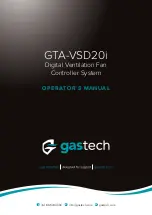
Page 13
© 2011 Gastech Australia Pty Ltd
4.
System Operation.
4.1
System Commissioning
Once a system has been wired up and all sensors connected, power should be checked on the connector plugs
before plugging them into the main module, extender module and HMI. If all power is present and correct,
then turn off the power supplies and connect the power plugs into each module.
Conduct a final check of all sensor wiring and signal connection to and from any other components in the
system (such as fan controller, sirens, beacons etc.).
If connection are all correct, then power can be applied to the system.
At power up, the modules establish communications and initialise to the working state. If a HMI unit has been
included in the system, failure to connect or initialise correctly will be signaled by the HMI issuing warning
beeps.
A normally running system will measure signals form connected sensors into enabled channels. The 0 - 10VDC
control voltage signal will set to a value based on the sensor that is detecting the highest concentration of
carbon monoxide. In an application with a normal ventilated condition, the output will be 0V. The variable
speed enable signal will also be inactive.
During the first system power-up, it is possible that the sensors will produce a signal that is above the pre-set
fan switch points. This is due to the initial warm-up characteristics of the carbon monoxide sensors. The
GasTech 'C-Guard' has a 60 second warm-up timer that holds the output signal at 4mA to allow the sensor to
stabilise. If sensors have been stored for a long time or stored in extremes of temperature, the settling time of
the sensors may be longer than the 60 seconds, resulting in a period where the signals into the controller are
seen as measured gas concentrations. The result of this is hat connected fan systems will activate until the
sensors stabilise to their normal base-line condition. If this is likely to cause a problem with the application,
please ensure that the enable and control signals are disconnected from the main control unit before
powering up for the first time.
4.2
Running The System
Once running, the system is automatic in operation. Each sensor is measured and the control unit processes
the signals and outputs the required signals based on the measured carbon monoxide concentration. If a HMI
has been included in the system, the 20 available channels can be viewed by using the 'NEXT' and 'PREVIOUS'
buttons.
4.2.1
Enabling a Channel (HMI required)
By default each channel is set to the off state. To enable a channel, press the on/off button that sits over each
channel icon.
4.2.2
Entering the Setup Password (HMI function)
A password is required to make the change. The default password is set at '12345678' The password is
entered on the keypad that appears on the HMI screen when an attempt is made to switch a channel on or off.
4.2.3
Normal Input Signal Operation
Once enabled, a channel expects to see an operational input current between 4mA and 20mA corresponding
to gas readings in the range 0 - 100ppm.
4.2.4
Fault Signal Indication
If any active channel receives an input signal less than the lower fault limit of 3.0mA a warning is given on the
HMI and the system fault relay will be active. This will signal a sensor fault or sensor disconnection.

















